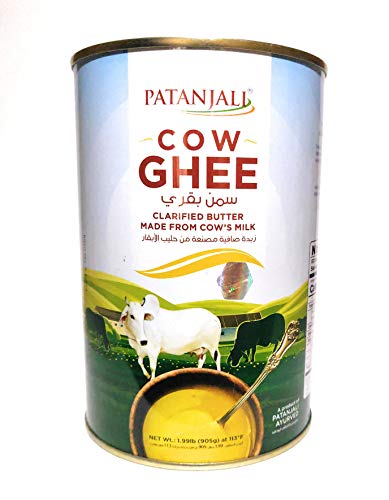- Features
- Description
- Similar Items
Rich in Anti-oxidants: Cow Ghee is sourced from grass-fed cows, therefore, it has a good presence of K2, butyric acid and CLA (Conjugated Linoleic Acid).
Cow Ghee helps in improving digestion by stimulating the secretion of stomach acid. It is also rich in butyric acid which helps in lowering inflammation and helps in digesting the food.
Cow Ghee is also known for its healing qualities. It is the best thing to apply on skin burns or sun burns. We have been hearing elders emphasising to use cow ghee for hair as it is it helps to cure dryness and relieves flaky scalps.
With about 450KJ of energy per tablespoon, cow ghee nutritional energy content high making it a storehouse of energy. The fatty acids present in cow ghee can be directly absorbed into the liver and burnt as energy.
Cow Ghee helps in improving digestion by stimulating the secretion of stomach acid. It is also rich in butyric acid which helps in lowering inflammation and helps in digesting the food.
Cow Ghee is also known for its healing qualities. It is the best thing to apply on skin burns or sun burns. We have been hearing elders emphasising to use cow ghee for hair as it is it helps to cure dryness and relieves flaky scalps.
With about 450KJ of energy per tablespoon, cow ghee nutritional energy content high making it a storehouse of energy. The fatty acids present in cow ghee can be directly absorbed into the liver and burnt as energy.
Binding:
Health and BeautyBrand:
PATANJALIEAN:
0051120170340Label:
PATANJALIManufacturer:
PATANJALIModel:
Size:
Warranty:
Ghee is typically prepared by simmering butter, which is churned from cream (traditionally made by churning dahi), skimming any impurities from the surface, then pouring and retaining the clear liquid fat while discarding the solid residue that has settled to the bottom. Spices can be added for flavor. The texture, color and taste of ghee depends on the quality of the butter, the milk source used in the process and the duration of time spent boiling. Traditionally, ghee (Sanskrit: गोघृत, go-ghṛta) is always made from bovine milk, as cows are considered sacred, and it is a sacred requirement in Vedic yajña and homa (fire rituals), through the medium of Agni (fire) to offer oblations to various deities. (See Yajurveda). Fire rituals have been performed dating back over 5,000 years[citation needed]. They are thought to be auspicious for ceremonies such as marriage, funerals, etc. Ghee is also necessary in Vedic worship of mūrtis (divine deities), with aarti (offering of ghee lamp) called diyā or dīpa and for Pañcāmṛta (Panchamruta) where ghee along with mishri (mishri is different from sugar), honey, milk, and dahi (curd) is used for bathing the deities on the appearance day of Krishna on Janmashtami, Śiva (Shiva) on Mahā-śivarātrī (Maha Shivaratri). There is a hymn to ghee. In the Mahabharata, the kaurava were born from pots of ghee. Finding ghee pure enough to use for sacred purposes is a problem these days for devout Hindus, since many large-scale producers add salt to their product. Ghee is common in cuisines from the Indian subcontinent, including traditional rice preparations (such as biryani). In Maharashtra, polis or Indian breads are accompanied with ghee. For example, 'Puranpoli', a typical Maharashtrian dish is eaten with lots of ghee. In Rajasthan, ghee often accompanies baati. All over north India, ghee tops roti. In Karnataka and Tamil Nadu, ghee tops dosa, and kesari bhath.






